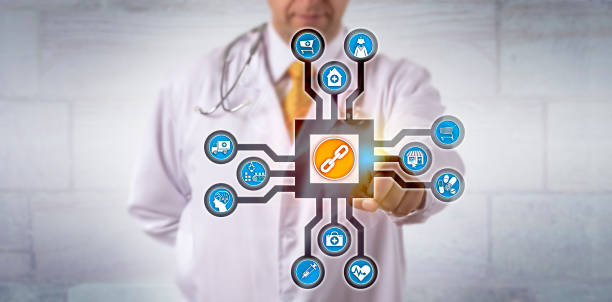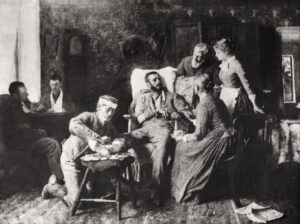What can we learn from the history of remote patient monitoring and telehealth, and what lies ahead? The COVID-19 pandemic fairly recently introduced many people to telemedicine’s lifesaving potential. However, telehealth and remote patient monitoring (RPM) technologies have quietly evolved several decades before the pandemic. Their growth trajectories have risen sharply in recent years and show no signs of slowing.
To understand where these fields are headed, examining their history and continuous evolution is instructive. This article will provide an overview of the origins of remote care, the key milestones in its development, and the factors that paved the way for its recent explosive adoption. We will also explore emerging trends and innovations shaping the next phase of telehealth and RPM technology advancement.
What’s the History of Remote Patient Monitoring and Telehealth? 1800-1900s
Before we discuss the future of remote patient monitoring and telehealth, we’ll start with the history of remote patient monitoring and telehealth. An 1879 article published in the Lancet is the first record of using the telephone in medical practice to help ease unnecessary office visits. The writer points out that the physician requested that an anxious new mother “be asked to be put on telephonic communication” following several communications.
In 1925, a cover of Science and Invention magazine highlighted a physician diagnosing a patient by the radio. Later, in 1888, rural doctor Dr. Alfred H. Twining wrote to the Lancet recommending the telephone for partnership practice. He suggested that even though doctors might be only a few miles apart, the phone allows for “prolonged social or professional conference by day or night. This theory has stood the test of time, leading to further advancements in the following sections.
History of Remote Patient Monitoring: 1950-the 60s
At first, telemedicine was referred to as “Telediagnosis.” However, hospital-based telemedicine technology was first introduced in the late 1950s and 1960s with a closed-circuit television link that NASA used when it partnered with the U.S. Department of Public Health, Lockheed, Nebraska Psychology Institute, and Norfolk State Hospital.
In 1963, John H. Knowles, MD, a Massachusetts General Hospital cardiopulmonary internist and MGH General Director, established the Logan International Airport MGH Medical Station telemedicine program (LIA-MGH-TP). Michael Crichton and Ronald S. Weinstein, MD, began training under Knowles in 1968 and became recognized as “pioneers in telemedicine training.”
Weinstein introduced telepathology, which uses telecommunications technology to facilitate the transfer of image-rich pathology data between remote locations for diagnosis, education, and research. He later invented, patented, and marketed robotic telepathology.
Del Mar Engineering Laboratories released the Holter monitor for widespread monitoring electrocardiography or (ECG) use in 1962. Today, the device’s ability to record data for extended recording periods still helps record data for later evaluation of cardiac arrhythmias that are often difficult to detect in a short period. Then, in 1967, physicians began transmitting electrocardiogram (EKG) signals over telephone wires to detect heart problems and monitor heart health.
History of Remote Patient Monitoring and Telehealth: 1980-1990s
When looking back at history, remote patient monitoring and telehealth in the 1980s focused on advancing the transmission of medical data. By the 1980s, the transmission of X-ray images was becoming routine. Workflow efficiencies eventually led to the sharing of CT and MRI imaging and lab data. Government telemedicine projects and initiatives also increased during this time, providing:
- Medical services to patients in war zones.
- Medical care in remote research stations in the Arctic and Antarctic.
- Medical services at correctional facilities, decreasing hospital transportation needs.
However, the introduction of the Internet in the 1990s was responsible for significant recent advances in telehealth. When broadband became available, telemedicine exploded, and healthcare data transmission and delivery became much more manageable and cost-effective. In addition, the Internet allowed medical organizations to effectively and efficiently transmit global data and connect with patients long distances. As a result, advances in remote patient monitoring became visible in primary care, chronic care follow-ups, and some acute care situations.
History of Remote Patient Monitoring: 2000s
From 2005 to 2017, telehealth visits grew 52% year over year. The increase in remote patient monitoring technology has allowed patients to stay in their homes and still receive quality healthcare. The following section describes how remote patient monitoring and telehealth in the 21st century shifted toward value-based healthcare.
Value-based care (VBC) programs are a quality strategy to reform how healthcare is delivered and paid for by Medicare. Additionally, value-based programs reward healthcare providers with incentive payments for the quality of care provided to Medicare patients.
VBC is a three-pronged approach to address the following:
- Creating better care for individuals
- Offering better quality health programs for populations
- Lowering the cost of healthcare
Healthcare costs have been on the rise over the past five decades. For example, prices have increased from $353 per person in 1970 to $12,914 in 2021. As a result, the concept of value-based healthcare arrived in 2006 when Michael Porter and Elizabeth Olmsted Teisberg published Redefining Healthcare: Creating Value-Based Competition on Results. In the years following, CMS started developing value-based program goals to pay providers based on quality care instead of the quantity of care given to patients.
The Future of Value-Based Care
Healthcare costs are rising globally due to hospital readmissions, aging populations, and increasing demand. Consequently, there is a shift towards value-based healthcare (VBHC). VBHC focuses on improving patient outcomes while reducing costs through better resource utilization. Value-Based care principles, introduced by Michael E. Porter, define value from the patient’s perspective as better outcomes achieved per dollar spent.
Generally, the principle of value-based care is that providers are paid based on patient and health system outcomes rather than treatment volume. Measuring the value of health outcomes often involves assigning monetary values to survival rates, recovery, and quality of life improvements. Debates around valuations of human life and quality of living continue to intensify in the current climate of rising healthcare costs and strained budgets.
A History of Value-Based Care Programs
Following the Medicare Improvements for Patients & Providers Act (MIPPA) in 2008 and the Affordable Care Act (ACA) 2010 in 2012, CMS began creating value-based programs to redefine and measure quality healthcare.
CMS has created 7 programs since 2012 that include:
- End-Stage Renal Disease Quality Incentive Program (ESRD QIP)
- Hospital Value-Based Purchasing (VBP) Program
- Hospital Readmission Reduction Program (HRRP)
- Value Modifier (VM) Program (also called the Physician Value-Based Modifier or PVBM)
- Hospital Acquired Conditions (HAC) Reduction Program
- Skilled Nursing Facility Value-Based Purchasing (SNFVBP)
- Home Health Value-Based Purchasing (HHVBP)
Many in the healthcare community find the greatest need in at-home monitoring for chronic disease. An estimated 75 percent of healthcare expenditures come from the 100 million Americans with chronic conditions.
Remote Patient Monitoring and Telehealth Now
In 2010, the Veterans Administration developed an at-home healthcare management program offering education, monitoring, and feedback from a remote disease management support team. Remote monitoring in chronic disease care is associated with reductions in hospitalizations, readmissions, lengths of stay, and costs.
In addition, RPM shows improvements in health outcomes across physiologic measures, including high rates of patient and provider satisfaction and better medication adherence. Cellular and Bluetooth remote patient monitoring devices and mobile apps are increasingly used with telemedicine and wearable devices to support remote patient monitoring (RPM).
The Future of Remote Patient Monitoring and Telehealth
Future opportunities for telehealth and remote physiology include determining evidence-based beneficial outcomes of telehealth and RPM and tailoring them to specific healthcare segments. For example, much of the expansion of hospital-based telemedicine has been with for-profit companies offering stroke and emergency care.
Many healthcare administrators focus on incentives for expanding RPM models to allow private and public institutions to offer these services in rural and underserved communities. In addition, with reduced readmissions, there may be more incentives for telemedicine and remote patient monitoring.
Remote Patient Monitoring and Blockchain Technology
Finally, with advances in the ability to continuously stream patient data have come security, storage, and retrieval challenges in electronic health record systems (EHR). Blockchain is an emerging distributed technology that can potentially solve issues around data risks in the collection, storage, and processing of electronic health records. In addition, Blockchain offers opportunities for remote patient monitoring using cost-effective blockchain techniques through Ethereum and Hyperledger Fabric technologies that securely store data.
Blockchain uses universal tools for cryptographic assurance of data integrity through formalized contracts required to access data in the Blockchain. This can be especially useful in healthcare when we think about enabling a comprehensive, interoperable, and secure exchange of patient records among multiple qualified healthcare providers.
Tenovi Now and in the Future
Tenovi’s FDA-cleared remote patient monitoring devices work right out of the box, eliminating the hassle of setting up the device. Healthcare providers receive automatic and secure transmission of patient measurements within seconds. We work exclusively with companies that offer remote patient monitoring services to healthcare providers, including rpm service and software companies, chronic care management companies, and telehealth companies. Visit tenovi.com to learn more about our no sync, no app remote patient monitoring hardware devices and software services.







